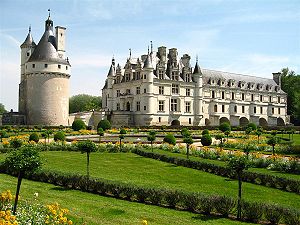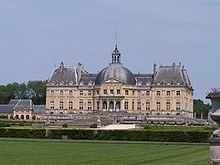- Château
-
A château (plural châteaux; French pronunciation: [ʃɑ.to] for both the singular and the plural) is a manor house or residence of the lord of the manor or a country house of nobility or gentry, with or without fortifications, originally—and still most frequently—in French-speaking regions. Where clarification is needed, a fortified château (that is, a castle) is called a château fort, such as Château fort de Roquetaillade. Care should be taken when translating the word château into English. It is not used in the same way as "castle", and most châteaux are described in English as "palaces" or "country houses" rather than "castles". For example, the Château de Versailles is so called because it was located in the countryside when it was built, but it does not bear any resemblance to a castle, so it is usually known in English as the Palace of Versailles.
The urban counterpart of château is palais, which in French is applied only to grand houses in a city. This usage is again different from that of the term "palace" in English, where there is no requirement that a palace must be in a city, but the word is rarely used for buildings other than the grandest royal residences. The expression hôtel particulier is used for an urban "private house" of a grand sort. Some castles are now used as hotels.
Contents
Concept
 Château de Ferrières, the largest Chateau of the 19th century, was built in 1854 to house James Mayer de Rothschild, east of Paris. It is set in a 30 km² estate.
Château de Ferrières, the largest Chateau of the 19th century, was built in 1854 to house James Mayer de Rothschild, east of Paris. It is set in a 30 km² estate.
If a château is not old, then it must be grand. A château is a “power house”, as Sir John Summerson dubbed the British and Irish “stately homes” that are the British Isles' architectural counterparts to French châteaux. It is the personal (and usually hereditary) badge of a family that, with some official rank, locally represents the royal authority; thus, the word château often refers to the dwelling of a member of either the French royalty or the nobility, but some fine châteaux, such as Vaux-le-Vicomte, were built by the essentially high-bourgeois — people but recently ennobled: tax-farmers and ministers of Louis XIII and his royal successors.
A château is supported by its terres (lands), composing a demesne that renders the society of the château largely self-sufficient, in the manner of the historic Roman and Early Mediæval villa system, (cf. manorialism, hacienda). The open villas of Rome in the times of Pliny the Elder, Maecenas, and Emperor Tiberius began to be walled-in, and then fortified in the 3rd century AD, thus evolving to castellar “châteaux”. In modern usage, a château retains some enclosures that are distant descendants of these fortifying outworks: a fenced, gated, closeable forecourt, perhaps a gatehouse or a keeper's lodge, and supporting outbuildings (stables, kitchens, breweries, bakeries, manservant quarters in the garçonnière). Besides the cour d’honneur (court of honour) entrance, the château might have an inner cour (“court”), and inside, in the private residence, the château faces a simply and discreetly enclosed park.
In the city of Paris, the Louvre (fortified) and the Luxembourg (originally suburban) represented the original château but lost their château etymology, becoming “palaces” when the City enclosed them. In the U.S., the word château took root selectively, in the Gilded Age resort town of Newport, Rhode Island, the châteaux were called “cottages”, but, north of Wilmington, Delaware, in the rich, rural “Château Country” centred upon the powerful Du Pont family, château is used with its original definition. In Canada, especially in English, château usually denotes a hotel, not a house, and applies only to the largest, most elaborate railway hotels built in the Canadian Railroad golden age, such as the Château Lake Louise, in Lake Louise, Alberta, the Château Laurier, in Ottawa, the Château Montebello, in Montebello, Quebec, and the most famous Château Frontenac, in Quebec City. Moreover, in other French-speaking European regions, such as Wallonia (Belgium), the word Château is used with the same definition. In Belgium, a strong French architectural influence is evident in the seventeenth-century Château des Comtes de Marchin and the eighteenth-century Château de Seneffe.
French Châteaux
 Château de Boisclaireau, residence of the Gueroust family, Counts of Boisclaireau, in the Loire Valley
Château de Boisclaireau, residence of the Gueroust family, Counts of Boisclaireau, in the Loire Valley
Loire Valley
The Loire Valley (Vallée de la Loire) is home to more than 300 châteaux. They were built between the 10th and 20th centuries, firstly by the French kings followed soon thereafter by the nobility; hence, the Valley is termed "The Valley of the Kings". Alternatively, due to its moderate climate, wine growing soils and rich agricultural land, the Loire Valley is referred to as "The Garden of France". The châteaux range from the very large (often now in public hands) to more 'human-scale' châteaux such as the Château de Beaulieu in Saumur which is built of the local tuffeau stone.
Vaux-le-Vicomte
The Château de Vaux-le-Vicomte is simililary a baroque French chateau located in Maincy, near Melun, 55 km southeast of Paris in the Seine-et-Marne département of France. It was built from 1658 to 1661 for Nicolas Fouquet, Marquis de Belle-Isle (Belle-Île-en-Mer), Viscount of Melun and Vaux, the superintendent of finances of Louis XIV.
Dampierre-en-Yvelines
Built by Jules Hardouin-Mansart, 1675-1683 for the duc de Chevreuse, Colbert's son-in-law, is a French Baroque château of manageable size. Protected behind fine wrought iron double gates, the main block and its outbuildings (corps de logis), linked by balustrades, are ranged symmetrically around a dry paved and gravelled cour d'honneur. Behind, the central axis is extended between the former parterres, now mown hay. The park with formally shaped water was laid out by André Le Notre. There are sumptuous interiors. The small scale (compared to Vaux-le-Vicomte for example) makes it easier to compare it to the approximately contemporary Het Loo, for William III of Orange. These really are "Mansart roofs."
Bordeaux
There are many estates with true châteaux on them in Bordeaux, but it is customary for any wine-producing estate, no matter how humble, to prefix its name with "Château". This is true whether the building itself is a magnificent palace or a shack. If there were any trace of doubt that the Roman villas of Aquitaine evolved into fortified self-contained châteaux, the wine-producing châteaux would dispel it. On the other hand there are many beautiful châteaux in the Bordeaux region still depicting this Roman villa style of architecture, an example of this being Château Lagorce in Haux.
See also
- Châteauesque
- Châteaux of the Loire Valley
- Faux château
- List of castles
- List of castles in France
- List of castles in Belgium
External links
- château d'Ussé, in the Loire Valley, home to the Duke of Blacas, it inspired Charles Perrault for his Sleeping Beauty
- Roquetaillade Castle (English)
- Château de Montreuil-Bellay (English)
- Château de Bellocq Bearn (French)
- Château of Gaston Phoebus at Morlanne in Bearn (French)
- Château de Cirey; residence of Voltaire (English)
Categories:- Châteaux in France
- French architecture
- French loanwords
- House types
Wikimedia Foundation. 2010.





